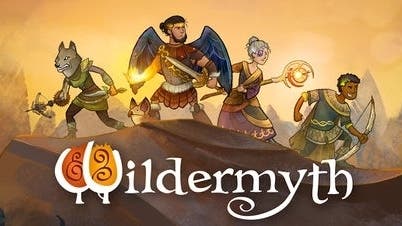Wildermyth review - a proper RPG marvel
Never trust a dream you dream in moonlight.
Wildermyth's heroes don't look like heroes. Not at the start, anyway. With their simple felt-pen facies, dots for eyes, kinked line for a mouth, they look like the chattering cast from a '90s newspaper comic strip, like Judge Reinhold captured by a funfair caricaturist, or like the cheery helpers that I might once have found inside an Usborne kids book that's trying to teach me about the nitrogen cycle. At first, this was a little odd, a little off, even. I'm going off on a searing adventure down into the flaming mines of lord whatever and I'm taking these rickety Dilberts with me?
Many hours in, I've started to suspect that the visual design of Wildermyth's heroes is actually something very close to genius. This is a complicated, potentially rather dense game - an RPG tactics affair, with a focus on procedural narrative and character development, character bonding. Look for depths, and the ground falls away obligingly in every direction. But Wildermyth never feels complicated. Its stacked brilliances never seem to teeter around you. And for a player like me, hesitant, impatient, perhaps a little dim, this is important. Wildermyth has riches, glorious riches, but it also wants you to stick around long enough to find them. It's wonderfully complex, but it's also simple to start playing, and simple to get your head around. Wildermyth, and Wildermyth's art, understands the importance of being approachable. You know, like a children's Usborne book that's teaching you about the nitrogen cycle.
It's more fun than that, and that's not to knock Usborne. In truth, I suspect Wildermyth is more fun than almost any game out there at the moment. I have been told to play this many times over the last year by colleagues and friends who are far smarter than me. Then they would start to describe Wildermyth, and I got a bit afraid. What awaits? Nothing less than the classic dungeons and dragons experience. A party, a quest, a bunch of nasty creeping things in the way. Twists! Loot! Choices! Lineages! Get at it. But listen: there is nothing to be afraid of. There is only joy, only treasure.
I am going to start with what initially seems to be the center of things - and a wonderful center it would make. As a tactical RPG, Wildermyth is firmly in the XCOM mould, which is to say it takes Firaxis' brilliant two-actions-per-turn template and spins it outwards into magic. XCOM could have been a frightening proposition in itself, but that two-actions business was inspired. Move your toy soldiers around. Go on. What can they do? Two things: move once, and shoot, or move twice and not shoot. Two points to spend per turn. That's the basics, a moveset that both promised mastery and threatened entrapment, a moveset that left you alone with your own tactical skills and shortcomings, and it was impossible not to get your head around that.
It's such a simple template that it copes very well with the kind of attendant complexity that makes these games truly tactical, and truly worth playing. When it's time for your party to battle in Wildermyth, you're all dropped into a little papercraft grid, folded card cut-outs providing the Mary Blair prop-trees and rocks and elven arches, as well as thickets of flame and hideous monsters and your own team even, each hero a millimeter thick, if that, but so full of heart. Turn by turn you move around, discovering enemies and attacking them, discovering enemies and being attacked. There are classes and melee weapons and ranged weapons and magic, most of which hinges on bringing rocks and trees and other parts of the scenery to life and turning it to your cause. You can hit someone with an axe, sure, but you can also blast a discus of stone from a pile of rocks, or turn tree bark into hot shrapnel and fling it at your foes. In Wildermyth, you can kill someone, and I am giddy just to type this, with a bookcase. And your enemies can kill you with a bookcase in return! And that's just the magic part. That's just magic users.
There are deeper complexities, but they reveal themselves over time. Placement is important because you can flank enemies for a greater chance at damage. Placement is also important because if you line up with your allies you can create a wall, for extra protection. That second move, if you put both your action points into movement, will leave you exposed, so think about cover. Think about lines of sight and any area-attacks that enemies bring. One absolute beast I loathe to see shambling towards me on the battlefield brings a whole annulus of sorrow, staining tiles around them a burning red that does an itchy, low-level kind of grief. So think about target-prioritisation too.


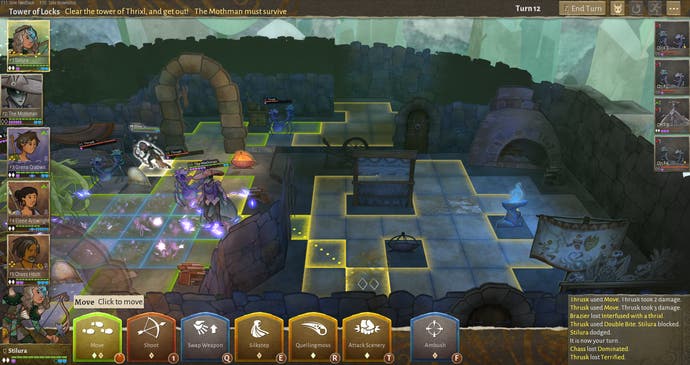
Combat's thrilling and full of taxing moment-to-moment choices as you advance across the elbowy terrain. It may be paper, but there's a sense of crunch and impact that makes it feel real - or fantasy real, which is probably even better. And in that peculiar way specific to turn-based tactics games, it's all richly storyful, too. So many sudden rescues, shocking twists in your fortune dictated by nothing but hidden dice rolls and movement ranges. Oh, the things that happen out there in the papercraft dungeons and vales!
Survive battles and you get loot - new weapons, new armour and trinkets. And you level up. This means your party members get to pick from a range of new passive and active skills, randomly shuffled, almost all of them brilliant. Want to deal more damage as you lose health? No problem. Want a spell-caster to be able to summon roots that clutch as well as discuses of stone and shredded bark? You got it. My favourite is a perk that allows you to go into the Wildermyth equivalent of overwatch at the end of every turn, regardless of what you spent your action points on. Emboldening. It's my favourite today, anyway. Who knows about tomorrow.
These skills tie into the rest of the game, the game played between the battles. And this is where Wildermyth has properly got to me.
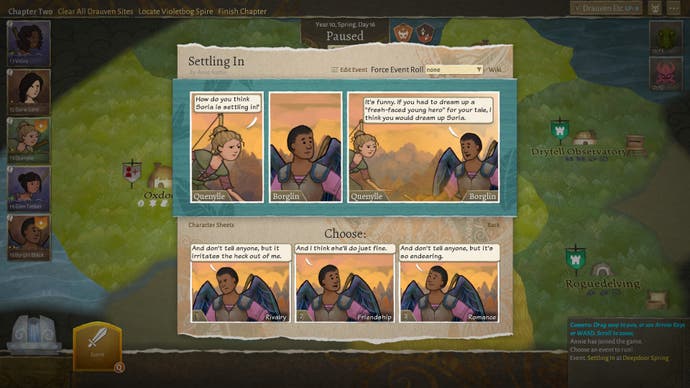

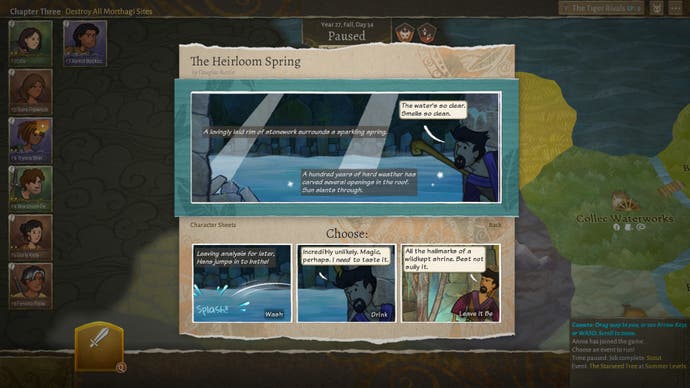
Campaigns are divided up into chapters - three for a short campaign or five for a proper belter. There are a handful of authored campaigns to start you off and then you can clump together procedural stuff pretty much until the sun explodes. But here's the thing: even the authored campaigns are filled with procedural stuff. You can play them again and again and they will feel different.
They'll feel different because you create different characters for your party for one thing. Alongside a range of classes you also get the important stuff: bookishness? Greediness? Hotheadedness? I went into battle with a bookish hothead, and let me tell you, it was very different to heading out with a goofish romantic. Different because of the things they do along the way - the bookish hothead was always making up stories and falling out with people - but also different because it was a prompt for me to think about these felt-pen characters a bit differently. Honestly, I was shocked to fight through five chapters with Bode Elderquill, who I would personally have diagnosed as a brotherly dreamboat by the end of it all, to find out that he was in fact a cowardly greedwagon. In the gap between how I saw him and how the game saw him, he became writable, he started to truly live.
So yes, your party matters - as you plod through your adventure they will forge alliances, fall out, develop rivalries and fall in love. One generation gives way to the next, which has its own challenges, its own possibilities. But the story matters too, the big beats - let's find out what this mothman is up to! - along with procedural scrapes along the way.
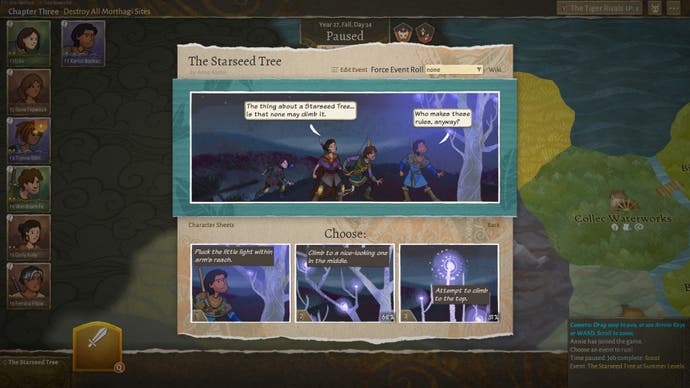
Take the mothman journey. It is a story about families, almost Shakespearian, but in between the big moments Wildermyth shuffles the paper and throws out mini-narratives. My main hitting-person guy heads into a dale and comes face-to-face with himself! A copy! Or is he the copy? A nice idea, but it's made brilliant with a choice: fight or flee, or talk? Come to understand the copy, if you risk it?
Another character spent a while trying to get a gem out of a wall or something only for it to explode and become embedded in their face. Another answered the call of the wolf god and became a wolf. These feel like spoilers, for which I apologise. But they won't be spoilers, really, because you may not see these things for hours as you play, and if you do encounter them, your characters will be different, the way you respond to things will be different.
What unites these stories is consequence and possibility: the chain of "buts" and "therefore" never ends. Like a good DM, Wildermyth understands that big choices should lead to an unexpected twist and more story, rather than the end of a story. Wildermyth flows.
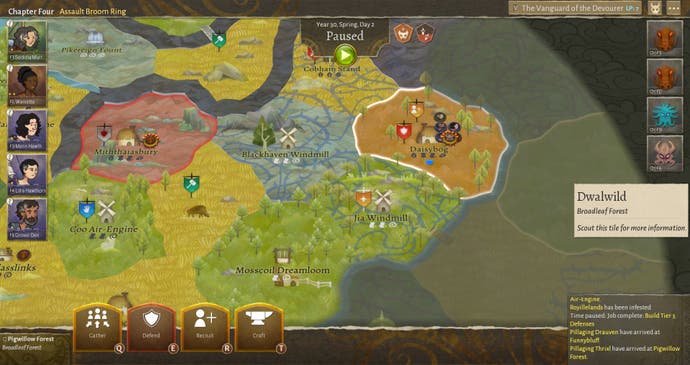
I'm still not done. The story unfolds as you move back and forth across a procedural map, scouting territories to find new combat encounters, or townships to fortify or turn into factories for the economy you need to level up your equipment. Time matters, because Wildermyth tells its stories in days and months and years as you travel from one area to another, or as you stop to build a path across a mountain or a bridge over a river. Your party matters because if you divide your forces to uncover more of the map you may end up creating weaknesses. The map matters - it's so dynamic. Enemy forces flock and multiply and stage incursions on your territory, just as the enemy unit types themselves may grow stronger or weaker depending on your actions in battle. This world, as Melville said, is a moving one. He wasn't talking about Wildermyth, but I reckon he'd have been up for a few games. The bookish romantic.
There is victory and sorrow here and genuine camaraderie as you learn more about your party, go through more with them, and inevitably - this itself is always a choice, rather beautifully - lose some in battle. I love the way Wildermyth embraces huge stretches of time, not just the time it takes to build a bridge - tricky if you have to complete a chapter before the summer's gone - but in the way that between chapters of the adventure you earn years of peace, and then you get to see what happens to your players during that peace. By the end of a yarn, you have been through things with these characters, and crucially they have changed. They're older. They've known love and loss. Granted, some of them are now wolves. Some of them even have pets!
Time matters, because Wildermyth tells its stories in days and months and years as you travel from one area to another, or as you stop to build a path across a mountain or a bridge over a river.
Even this is not the end. My favourite screen in all of Wildermyth is the My Legacy screen. It's where the heroes you've taken through campaigns come to hang out afterwards - even the dead ones. You can take them back into new campaigns where new stories and new choices and new dangers awake. And you can look through their stats and their histories and see how much they've been through up until now. The skills and perks, sure, but also the campaigns they've been on. The relationships they've had. The things you now think of when you think about them. It never has to end. The leveling, the deepening, never has to end.
It's sort of like Mii Plaza, the My Legacy screen. And like the Miis, that carefully accommodating art style does a lot. Doesn't it? I look at Chass Hitch, my goofy romantic, my level 2 warrior, my 43-year-old heroic flirt, and I seem to see nuance in the black dots of his eyes, in the slow greying of his beard. He looks tired but optimistic. He has beaten crab-things and mechanical beasts. He met himself in the woods and did quite well out of it. At least I think it was the him-him I ended up with after that encounter. This art style, with its perfect MOR blandness, is ideal for projection - it's the place where the game and the player meets, to accommodate everything the character has done and everything they may do in the years to come. And that, ultimately, is Wildermyth.
